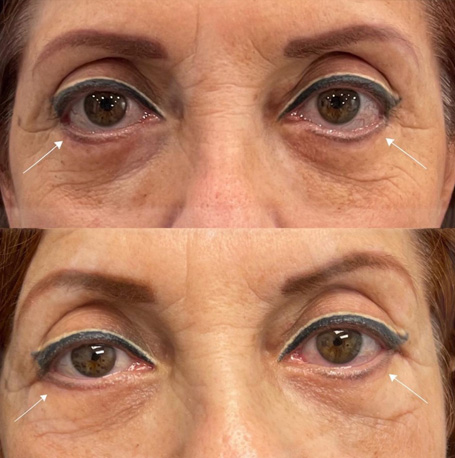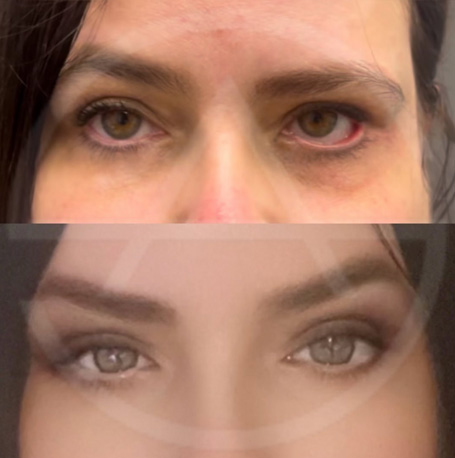
Canthoplasty and Canthopexy
Table of ContentsToggle Table of ContentToggle
What Is a Canthoplasty?
Canthoplasty is a surgical procedure that involves the reconstruction or repositioning of the lateral (outer) canthus of the eye. The canthus is the corner of the eye where the upper and lower eyelids meet, and it plays a crucial role in the proper alignment, function, and aesthetics of the eyelids. Canthoplasty is primarily performed by experienced oculoplastic surgeons for various medical and cosmetic reasons.
Here’s an overview of canthoplasty:
- Functional Canthoplasty: Canthoplasty is often performed to address functional issues with the eyelids. Common indications for functional canthoplasty include the correction of ectropion (outward turning of the eyelid), lower eyelid retraction (lower than normal position of the eyelid), and lateral canthal laxity.
- Lateral Canthal Laxity: Lateral canthal laxity refers to a weakening or loosening of the tissue that supports the outer corner of the eye. This condition can result from aging, previous surgeries, or other factors. Canthoplasty can be used to tighten the lateral canthus, restoring proper eyelid function.
- Surgical Procedure: During surgery, the surgeon makes small incisions at the outer corners of the eye. The procedure may involve the removal or repositioning of tissue, including the lateral canthal tendon, to achieve proper eyelid alignment and function.
- Closure and Healing: After the necessary adjustments have been made, the incisions are carefully closed with sutures. Over time, these sutures dissolve or may be removed during a follow-up appointment. The healing process can take several weeks, and patients may experience some temporary bruising and swelling.
- Additional Surgeries: Depending on the severity of the eyelid condition, a canthoplasty may be combined with other procedures such as skin grafts, spacer grafts such as hard palate or ear cartilage grafts, midface lifts, and more.
- Cosmetic Canthoplasty: In addition to functional canthoplasty, there is a cosmetic variation known as cosmetic canthoplasty. This procedure is primarily performed to modify the shape and appearance of the eye for aesthetic reasons. Cosmetic canthoplasty can create a more “upward” or “cat-eye” appearance by altering the angle and position of the lateral canthus.
Canthoplasty is a specialized procedure that requires the expertise of an oculoplastic surgeon experienced in eyelid and canthal surgery. Dr. Sarah Avila is a double board-certified oculofacial surgeon in Miami who specializes in eyelids and canthoplasty surgery.


What Is a Canthopexy?

The primary purpose of canthopexy is to provide additional support to the outer corner of the eye, helping to prevent or correct conditions like lateral canthal laxity, which is the weakening or loosening of the tissue that supports the lateral canthus. This condition can lead to issues like ectropion (outward turning of the eyelid) or lower eyelid retraction (drooping of the lower eyelid), affecting eyelid function and eye appearance.
Here’s how canthopexy works:
- Reinforcement of Lateral Canthus: During a canthopexy, the surgeon tightens and reinforces the lateral canthus by suturing it to adjacent structures or tissues, such as the bone or periosteum (the tissue covering the bone). This added support helps maintain the proper alignment of the eyelids and canthus.
- Correction of Lateral Canthal Laxity: Canthopexy is particularly useful for addressing mild to moderate lateral canthal laxity. By providing extra support to the outer corner of the eye, it helps prevent or correct conditions like ectropion and improves the overall function and appearance of the eyelids.
- Additional Surgeries: Depending on the severity of the eyelid condition, a canthopexy may be combined with other procedures such as skin grafts, spacer grafts such as hard palate or ear cartilage grafts, midface lifts, and more.
- Combination Surgery: Canthopexy can be performed in conjunction with other eyelid surgeries, such as blepharoplasty (eyelid surgery) or ptosis repair (correction of droopy eyelids), to achieve comprehensive improvements in eyelid function and appearance.
- Cosmetic Canthopexy: In addition to functional canthopexy, there is a cosmetic variation known as cosmetic canthopexy. This procedure is primarily performed to modify the shape and appearance of the eye for aesthetic reasons. Cosmetic canthopexy can create a more “upward” or “cat-eye” appearance by altering the angle and position of the lateral canthus.
It’s important to note that canthopexy is a less invasive procedure than canthoplasty, which involves more extensive reconstruction of the lateral canthus. The choice between canthopexy and canthoplasty is based on the specific needs and goals of the patient, with canthopexy typically recommended for mild to moderate cases of lateral canthal laxity and when less extensive surgical intervention is required.
Whether for functional correction or cosmetic enhancement, the decision to undergo canthopexy or canthoplasty should be made in consultation with a qualified oculoplastic surgeon, who can provide a thorough evaluation and recommend the most appropriate approach based on the individual’s condition and desired outcomes. Dr. Sarah Avila is a double board-certified oculofacial surgeon in Miami who specializes in eyelids and canthoplasty/canthopexy surgery.

Sarah Avila, MD
Specialization: Eyelid Surgery & Aesthetics
Dr. Sarah Avila is an oculofacial plastic surgeon in Miami, Florida. After completing medical school, Dr. Avila completed a residency in ophthalmology at the Mount Sinai Hospital, followed by a highly competitive two-year ASOPRS-accredited fellowship in reconstructive and cosmetic oculofacial surgery at Emory University. During this fellowship, Dr. Avila focused on plastic surgery related to the eyelids, brows, lacrimal duct system, orbit, and face.



